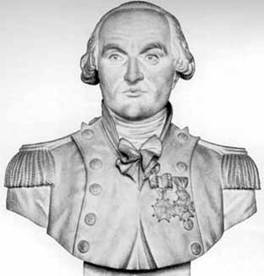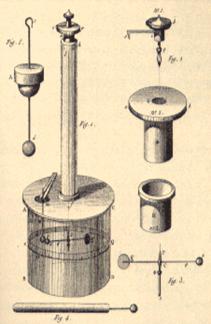Handout #6: Charles Coulomb (1736-1806)

While living in Paris, Coulomb researched the friction of machinery, windmills, and the elasticity of metal and silk fibers. He developed his theories while attempting to investigate the law of electrical repulsions. It was then that through the clever use of a torsion balance he discovered what is now known as Coulomb's Law, which states:
"The force that one particle exerts on another particle is directly proportional to the product of their charges and inversely proportional to the square of their separation."
This can be expressed as: |
Where Fe is the force of electricity between charges of strength q1 and q2 that have a distance d between them, and where k is a proportionality constant that is determined by the units for q and d. The unit of strength for electrical charges (q) is now known as the Coulomb in his honor.
Coulomb's Law was not actually discovered by Charles Coulomb – it was discovered by Henry Cavendish. However, Cavendish did not publish his results, and his documents were not discovered until half a century after his death. This was lucky for Coulomb, since he received the credit and fame for this spectacular discovery.

In the figure above, F21 means “the force of charge q2 on charge q1” or more simply “the force of 2 on 1”.

 Torsion Balance
Torsion Balance
Charles Augustin de Coulomb invented the torsion balance which could measure electrostatic force. Inside the balance are two pith balls. One is mounted and unmovable, the other is mounted on an arm that can spin on an axis. When the two pith balls are energized by a like electrostatic charge the moveable one will be repelled from the stationary one. It will move towards the stationary pith ball if each receives a different charge. The distance it moves is used to measure the electrostatic force. Coulomb was able to measure the torsion on the fiber with the scale near the top of the device and the distance between the balls on the scale that circumscribed the jar. He was able to derive a mathematical equation that described the relationship between these two variables. The force between two small, charged spheres is shown to be proportional to the magnitude of either charge and inversely proportional to the square of the distance between centers. This torsional balance device requires low humidity!